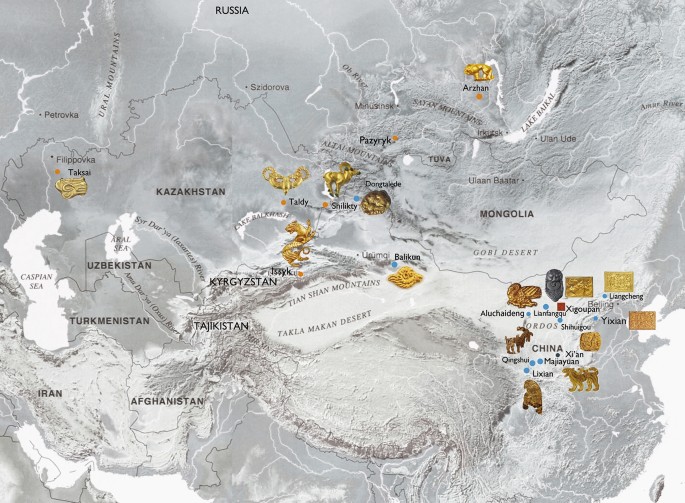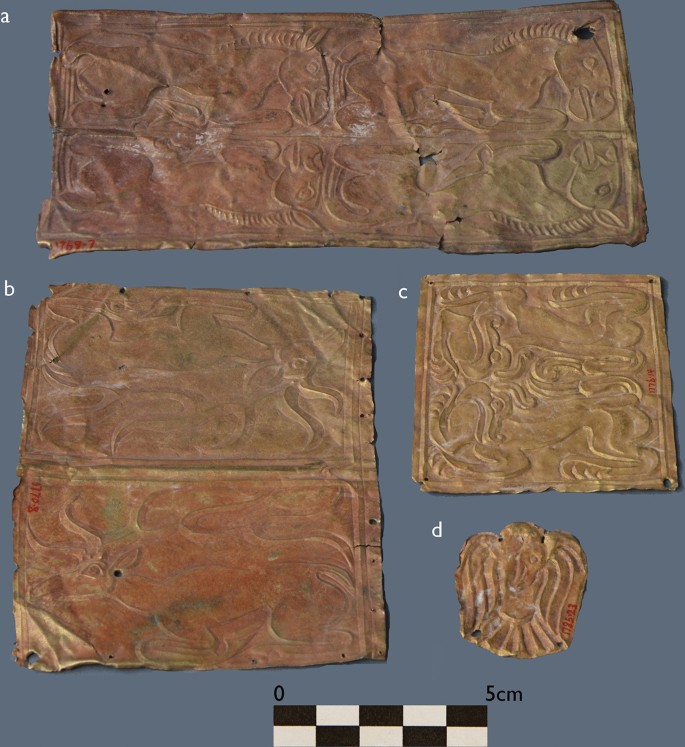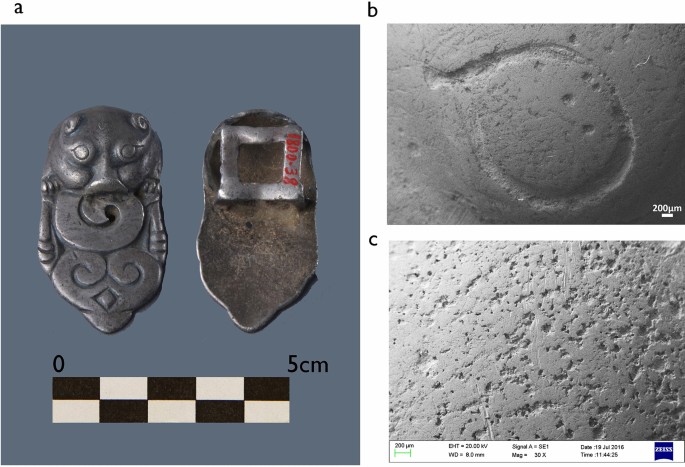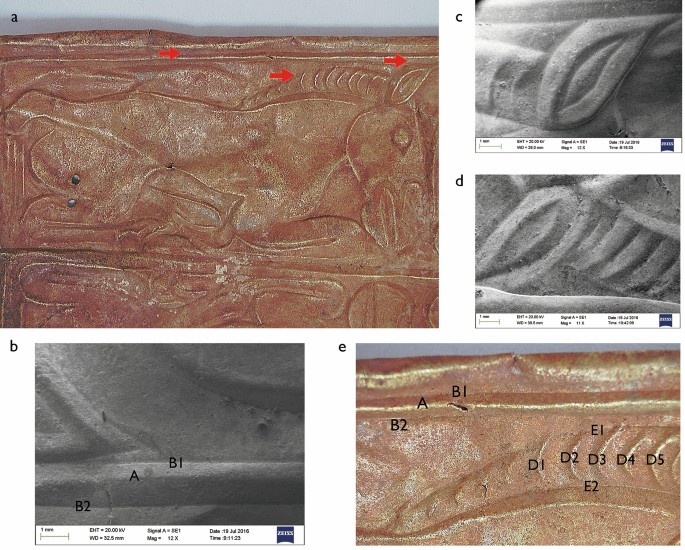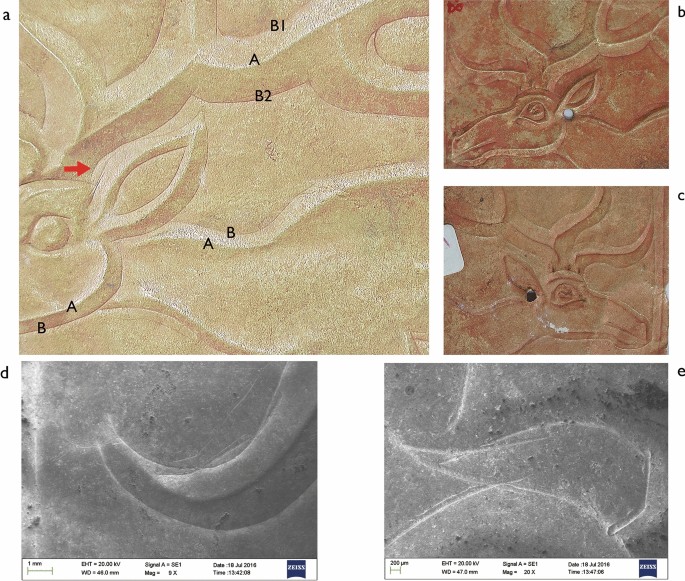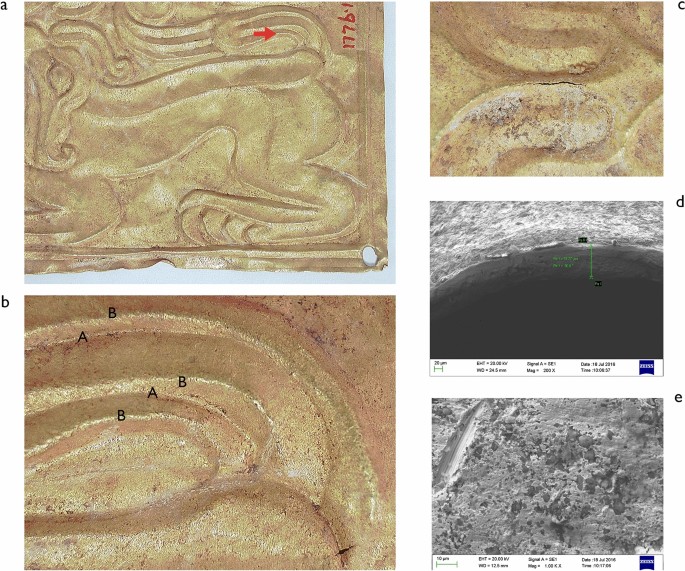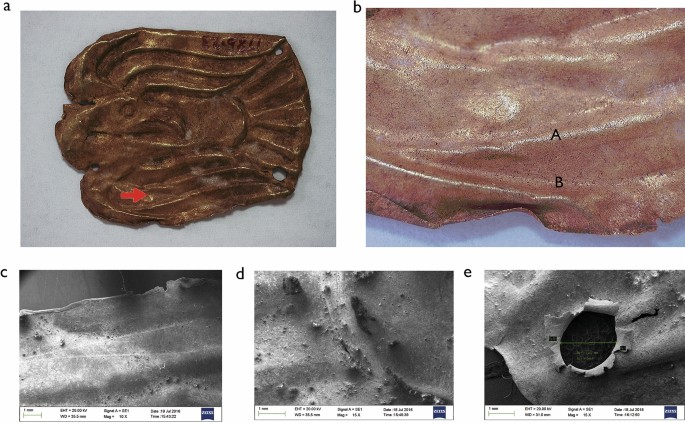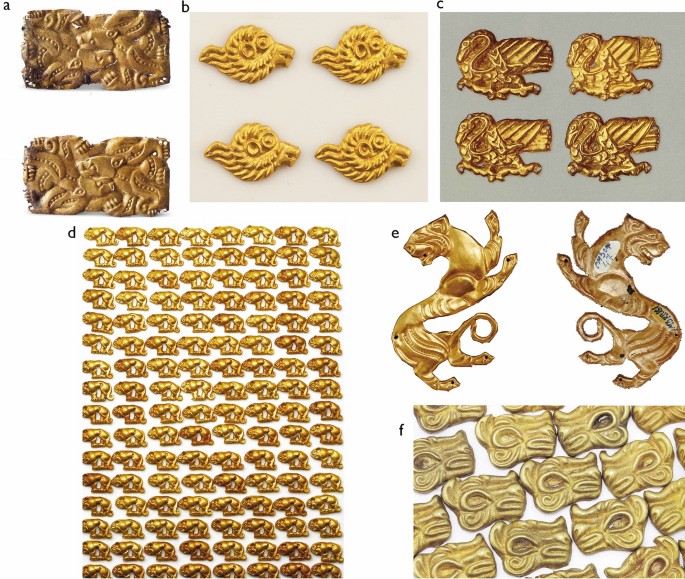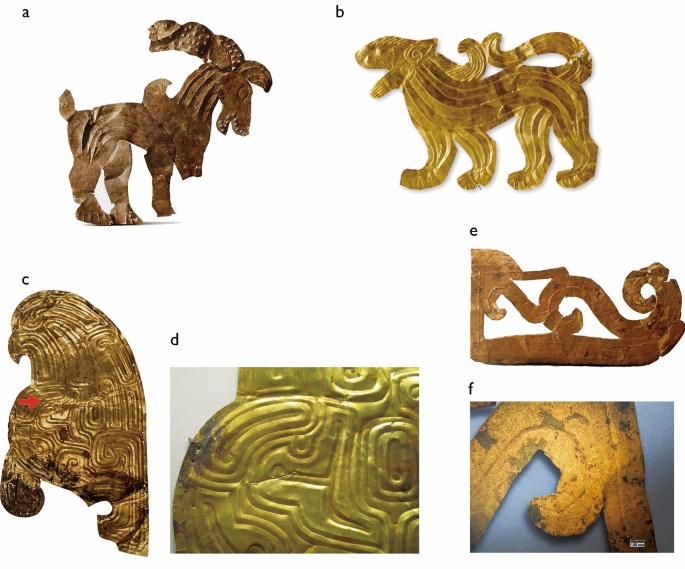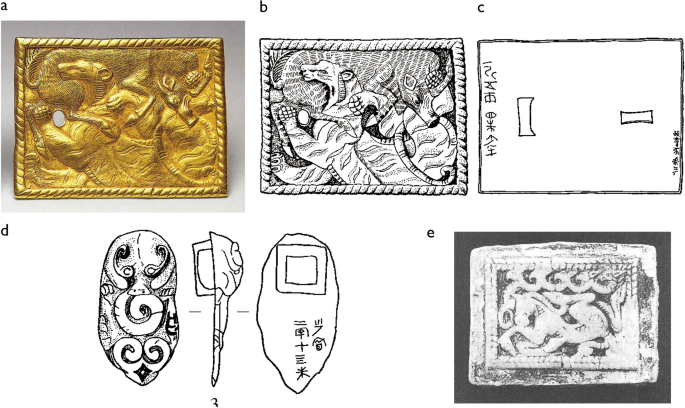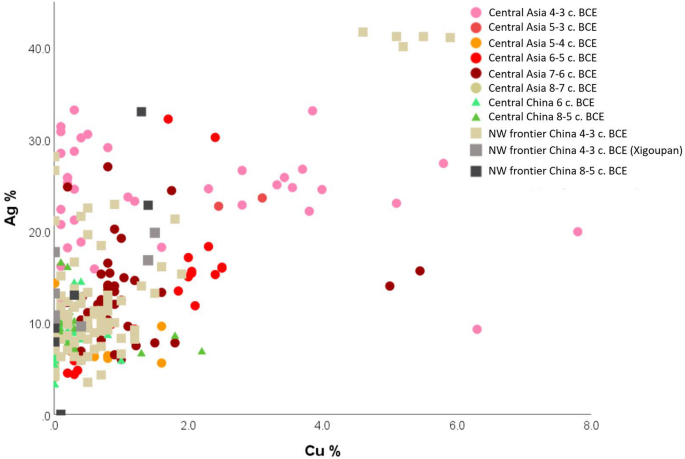China and the steppe: technological study of precious metalwork from Xigoupan Tomb 2 (4th–3rd c. BCE) in the Ordos region, Inner Mongolia (original) (raw)
Introduction
As a symbol of prestige and power, gold was treasured for its monetary and aesthetic value by both pastoral and sedentary people in ancient Eurasia. Gold use had a much longer history in the Eurasian steppes, but it was entirely new to people living in the Central Plains of China between the 9th and the second century BCE. From the fourth century BCE onward, on China’s northwest frontiers, new metal working technologies and iconographies were introduced and incorporated into local social practices, and then further linked with the construction of individual or group identities in these new contexts of interaction [1,2,3]. The influence of steppe art on the pre-imperial period gold artifacts found in Northwest China has been extensively discussed by many scholars [4, 5]. It is generally accepted that gold-making technology was one of the foreign borrowings when China intensively interacted with the mobile pastoralists in the Eurasian steppes between the fifth and fourth century BCE [6, 7]. However, some key questions as to whether and which local inventions occurred as a response to outside stimuli, however, remain insufficiently explored.
The remarkable discovery of gold and silver artefacts on Chinese northern frontiers provides valuable material with which we can gain a better understanding of the early development of gold-making technologies in early China. The Xigoupan cemetery in the north of Jungar Banner, the Ordos region of Inner Mongolia (Fig. 1), was excavated between 1979 and 1989, comprising twelve rectangular shaft graves. The intact M2 yielded the largest number of gold and silver artefacts. Here, a male adult was interred with seven bronze arrow heads, four deer-shaped objects and seven silver harness ornaments. A gold torc was found around his neck and a pair of gold earrings had been placed at his head along with a small gold roundel. At his right hand was an iron sword with a wooden scabbard elaborately decorated with gold appliqués. A pair of gold belt plaques were found at his waist with some silver foils scattered around. In M3 bronze objects prevailed and the other tombs were more simply furnished and contained potteries, iron knives and bronze rings [8]. This burial site was customarily considered as to have been a major hub of the Xiongnu (209 BCE-150 CE), a tribal confederation described in the Han texts [9]. However, materials from the site, including M2, date back to before the Xiongnu era.
Fig. 1
Geographical distribution of early gold and silver artefacts found in Northwest China and Central Asia (eighth-third century BCE)
Early pastoral groups living in the lands in present-day Inner Mongolia since the beginning of recorded Chinese history are known to us as the Rong, Di and Hu that have been often described in the written texts [10], but little is known about their technologies, art forms and power relationships. The remarkable discoveries of objects made from precious metals in Xigoupan and other sites in the Ordos region attracted wide scholarly attentions, and encourages a more in-depth examination of the production, consumption and circulation of prestige goods and power relationships on the northwest Chinese frontiers. Some of the cast gold and silver artifacts of Chinese origin uncovered at the Xigoupan site were thought to be imports from northern China, or cast by Chinese craftsmen in local employ [11,12,13,14]. The accumulation of this type of luxury gold items in the elite tombs at Xigoupan attested to prestige goods-centered economic and cultural interactions with China [15, 16]. Quite a few scientific analyses have been undertaken to examine the technical features of the gold and silver artifacts found in the Ordos region. For example, Wang and Harutaro applied portable XRF methods for the elemental analysis of 57 gold and silver objects from the Ordos Museum Collection, including 19 gold and eight silver artifacts found in Xigoupan M2. The results showed that the precious metalwork uncovered there was similar in composition to other contemporary samples from the Nianfangqu and Shihuigou sites in Inner Mongolia [17]. Due to the limitations of a portable XRF analysis [18, 19] and the insufficient study of manufacturing techniques, the questions about the provenance and origin of the Ordos artefacts, especially the gold appliqués rendered in the Scytho-Siberian animal style, remain unsolved [20].
This paper presents an interdisciplinary scheme employed for studying the ancient technologies of precious metalwork, with the goal of understanding the technical practice, style and craftworking traditions that constituted group membership of those artisans from whom the elite commissioned the precious metalwork on northwest Chinese frontiers. This research brings material science into the domains of artistic and archaeological inquiries, drawing comparisons between manufacturing techniques, styles and iconography. Considering that typological analyses have limitations in the case of unique or unprecedented objects, the systematic investigation conducted here into the technical features, chemical composition, stylistic characteristics and craftsmanship traditions enable us to identify whether and why these artefacts were created by local innovators in response to a particular stimulus, typically from the outside world. Multiple non-invasive methods, such as a 3D digital microscopy, and a scanning electron microscopy, including an energy dispersive spectroscopy (SEM–EDS), were used to examine the technical features of the samples in order to obtain a greater depth of analysis and attain a better integration of the compositional data.
Samples and methods
Samples
Five representative samples were selected from a variety of gold and silver artefacts originally excavated from Xigoupan M2 and currently preserved in the Ordos Museum in Inner Mongolia. The objects selected for the non-destructive analysis conducted as part of this research were labelled XGP 1769.7, XGP1770.8, XGP1776.14, XGP1785.23 and XGP1800.38 (Table 1).
Table 1 Selected samples from Xigoupan M2
XGP 1769.7
A rectangular gold appliqué with reclining horses in profile, measuring 11.7 cm in length and 5.7 cm in width. The four horses were rendered in two mirror-image pairs vertically flanking the central line vertically. Each pair is composed of two horses with bent legs facing rightwards. (Fig. 2a).
Fig. 2
a–d Gold artefacts from Xigoupan M2 selected for analysis
XGP 1770.8
A gold appliqué with low-relief deer images, measuring 10.9 cm in length and 7.9 cm in width. The rectangular plaque is divided into two parts by several raised horizontal lines in the center. Both the upper and the lower parts depict a deer with flowing antlers and bent legs respectively. Apart from the mirror-image pairs of reclining horses, these two deer figures are positioned in opposite directions. Several small holes are perforated into the edges for the purpose of sewing onto cloth or leather (Fig. 2b).
XGP 1776.14
A gold appliqué with a pair of beasts in mirror image format, measuring 7.6 cm in length and 7.0 cm in width. The rectangular appliqué has a flattened surface. The thin gold sheet is decorated with a pair of recumbent beasts with limbs extended forward and the tail rolled up within the raised border lines. Seven appliqués with the similar designs and dimensions were excavated from Tomb 2 of Xigoupan cemetery (Fig. 2c).
XGP 1785.23
A gold appliqué in the form of a standing eagle or bird with outstretched wings and a tail, measuring 4.7 cm in length and 3.4 cm in width. The facial representation of the bird contains a round eye and a very long curved beak. The appliqué is decorated with raised lines, with four perforations along the edges. Seven similar objects to this one were found in this burial site (Fig. 2d).
XGP 1800.38
A silver horse harness ornament in the form of a feline face with raptor elements, measuring 2.9 in length and 6.0 cm in width. The feline shows a frontal image with ears and paws. A stylized bird’s head with a longer spiral hook appears to be holding the tiger’s head. Underneath the longer hook, a pair of confronting raptor heads appear in a cloud pattern. The reversed side reveals one large square attachment loop, and some incised Chinese characters are noticeable. Seven similarly decorated silver objects were found in this burial site (Fig. 3a).
Fig. 3
a Silver horse harness ornament (XGP1800:38); b SEM image of carve mark on the feline’s head; c SEM image of the detail of tiny pores resulting from casting
Methods
We conducted non-destructive analyses using a combination of 3D digital microscopy and scanning electron microscopy with an energy dispersive spectrometer (SEM–EDS). The microscopic observation entailed examining the tool marks on the front of each artefact and the deformations on the back. The observation of tool marks enabled us to trace the specific manufacturing techniques and decorative methods employed by the artisans. The metal composition was also obtained by means of SEM–EDS. A micro scale investigation is essential to the identification of diagnostic markers related to the particular processes applied to the materials.
Optical microscopic analysis (OM)
The samples were photographed using a 3D digital microscopy (HIROX KH-7700, Japan) with large scene depth. The observations were carried out with high-resolution HD (1600 Å ~ 1200), as well as a multi-focus system.
Scanning electron microscopy with energy dispersive spectrometer (SEM–EDS)
The morphology analyses were performed using a SEM (ZEISS EVOMA25, Germany) for the purpose of observing the surface of each artefact as it relates to the manufacturing process. The composition analyses were undertaken by EDS (Oxford X-MAX 20, UK). The SEM–EDS operating conditions consisted of a line-avg mode with 20 kV accelerating voltage and an EDS working distance of around 8–9 mm. The measurement time for each analysis was set as 60 s, with around 30% of dead time to maintain Si-Li detector saturation. The standardless calibration mode is employed with INCA EDS software, with the default critical energy line series selected for each targeted element (e.g., copper K lines). The beam size is 40 μA. The minimum detect limit for gold, silver and copper is 0.1%. Standard deviation is around 1% and relative error is around ± 3%. At least three micro-areas were analyzed in every zone, and the elemental results detected were averaged and normalized.
Results
Manufacturing techniques
Casting
The microscopic examination showed that the silver horse harness ornament (XGP 1800.38) was made through casting, and that certain facial details of the feline’s head were additionally executed by carving. The feline is depicted in a lively way. The bulging eyes of its head are formed of a convex boss with an incised circular rim, and then the corners of its eyes extended to the coiled ears. The orbital lines of the eyes appeared flat and smooth under analysis. Sunken lines were made by carving on the front of the eyes, as seen in Fig. 3b. Some tiny pores of various dimensions appear on the surface of the forehead, resulting from the metal casting process (Fig. 3a). Silver would absorb a lot of oxygen during melting, it’s maybe a common phenomenon in ancient silver casting. The irregular tiny pores became more evident in the SEM image, and the porosity seems to have no uniform pattern. The occasional pores observed beyond the vicinity of the surface are very small (Fig. 3c). These technical details revealed by the microscopy indicate that the horse harness ornament was made using the casting technique. In addition, some Chinese characters (see Discussion) were carved on the underside after the casting was completed, as seen in the magnified image.
Double-sided carving
The microscopic examination revealed a range of common features amongst the group of gold appliqués analyzed, suggesting that they were made by double-sided carving using a pointed tool, but not a very sharp one. The features identified under the microscope and via the SEM include cutting edges, carved or incised marks, and perforated traces. The SEM–EDS results appear to be consistent with the results of the OM analysis of the appliqués (XGP 1769.7, 1770.8, 1776.14, and 1785.23).
Plaque XGP 1769.7 was seen to bear raised border lines in a rectangular form, with the thin gold sheet having been given folded edges to increase its strength. There are small pierced holes on the edge of the plaque, indicating that it was originally attached to an object. While the horse figures contained in the sample look very similar in form and dimension, there are certain subtle variations that could be seen in the ornamental details. The microscopic examination allowed for the identification of decoration carried out with particular tools. As seen in Fig. 4a, the convex border line A was formed by deep carving from the back, while the craftsmen repetitively carved the other two concave border lines, B1 and B2, from the front to create three-dimensional effects (Fig. 4b). Likewise, the double-sided carving was also employed to create the raised lines of the horse ear (Fig. 4c, d). The ornamental details of the horses’ manes are highlighted by convex lines D1-D5, made by deep incising from the back, while the concave ones, E1 and E2, were carved onto the front, as seen in Fig. 4e. The raised figure was created with the double-sided carving, and no trace of hammering on the inside could be found.
Fig. 4
a Detail of the convex border lines and horse manes on the front side of XGP 1769.7 under the microscope; b SEM image of the border lines; c SEM image of horse ear on the front and d the back; e front of carve marks of horse mane under microscope
Samples XGP 1770.8, 1776.14 and 1785.23 were made in the same manner. The three appliqués were made of gold plates with a similar thickness (80 μm in average), much thinner than the plaque with reclining horses. As seen in the magnified image of XGP1770.8, all carvings had a very sharp edges on both sides, such as those found in the details of the deer’s head, antlers and ears (Fig. 5a), indicating the use of a pointed tool. Such a tool is likely to have been made of bone, for a bronze one could easily tear the gold foil. The deer’s head and body were carved with precision. Under the microscope, it was possible to see that the raised line, A, of the antler was formed by deep carving from the back, while the concave lines, B, were made by shallow carving from the front (Fig. 5b, c). The SEM examination further revealed concurrent irregularities and imperfections in the incised lines connecting the confronting arcs (Fig. 5d, e), indicating that these lines had been made freehand.
Fig. 5
a Detail of deer’s antler, ear and body on the front side of XGP 1770.8 under the microscope; b front of the deer’s head; c back of the deer’s head; d SEM image of the front of imperfect carve marks of the antler; e detail of imperfect carve mark
Similarly, the low-relief of XGP 1776.14 was also created by double-sided carving. The front of the raised animal figures appears convex while the underside looks sunken. A perforated hole was found at each corner of the appliqué. The details under the microscope reveal that the convex line, A, was made from the back and the concave lines, B, were incised from the front (Fig. 6a, b). Some small cracks were generated by means of deeper carving (Fig. 6c). The thin gold sheet is only 80–100 um thick (Fig. 6d), and the deep carving emerged more markedly in the SEM image (Fig. 6e).
Fig. 6
a Double-sided carvings on the surface of the plaque XGP1776.14 under microscope; b detail of concave lines from reverse side; c small crack on reverse side; d SEM image showing the thickness of the gold sheet, 80–100 µm; e SEM image of deep carve mark
Sample XGP 1785.23 is shaped as a standing eagle. The initial contour of the eagle was carved out from a thin gold sheet. The surface observed by the optical microscope exhibits similar marks of having been carved on its both sides (Fig. 7a, b). The edges show a parallel line of cutting pre-tracing and straight, clearly visible marks (Fig. 7c) in the SEM images. The microscopy also identified several small cracks, which were more obvious on the outer surface as seen in Fig. 7d, resulting from stronger carving. Perforations could be seen on the ends of the eagle-shaped appliqué that were made using circular section punching (Fig. 7e), and which was easily recognizable from the round burrs seen on the back of the metal work.
Fig. 7
a Eagle shaped appliqué (XGP 1785:23); b detail of carved lines on the front side of XGP 1785.23 under microscope; c SEM image of carve mark; d a small crack on the front of the appliqué; e perforation trace
Elemental composition
Using SEM–EDS, our analysis of the metal composition of the gold and silver artefacts of Xigoupan M2 showed that the gold plaque (XGP 1769.7) was produced with natural gold, containing 81.1–91.0% gold and 9.0–18.9% silver without copper. A similar compositional pattern is also found in the metal elements of the sheet gold depicting beasts facing one another (XGP1776.14), namely, 88.6–91.0% gold and 9.0–11.4% silver without copper. The remaining items contained a higher percentage of gold and varying amounts of silver with a very low percentage of copper: the gold appliqué (XGP1770.8) consisted of 78.4–83.2% gold, 15.5–19.8% silver and 1.3–1.9% copper while the eagle-shaped appliqué (XGP 1785.23) was made up of 88.2–93.2% gold, 6.0–12.6% silver and 0.8–1.0% copper (Table 2). These percentages fall in the natural permissible range identifying natural gold from northwest China [21]. In contrast, the concentration of silver in the silver horse harness ornament (XGP1800.38) was between 87.1 and 97.6% (Table 3).
Table 2 Elemental composition of gold artefacts found in Xigoupan M2
Table 3 Elemental composition of silver object found in Xigoupan M2
Discussion
Gold owes its cultural and economic significance to its extraordinary malleability. In antiquity, a gold ingot or rod was beaten until it turned into a thin sheet, following which specific decorations could be created through a variety of methods: carving, chasing, engraving and repoussé, or even embellished with granulation and filigree. In Bronze Age China, gold foils were used for the surface decoration of bronzes and lacquers; one of the finest examples of these is the sheet gold, about 10 μm thick, found at the Yinxu site (thirteenth-eleventh century BCE) in Anyang [22]. The serial production of gold appliqués took place on northwest Chinese frontiers as early as the eighth century BCE. In tomb 3 of Dongtalede cemetery (eighth-seventh century BCE) in the Xinjiang Altai region, a large number of gold appliqués embossed with snow leopards were found, together with gold granulated ornaments, earrings and beech-nut pendants [23]. Such serially produced gold and silver plaques became more common in the Ordos region during the fourth century and the third century BCE. In addition to the remarkable find uncovered in Xigoupan cemetery, other excellent examples include the gold plaques with entwined dragons excavated from a golden hoard at Nianfangqu [24], the silver plates in the form of hedgehogs discovered in the burial site of Shihuigou [25], and the recumbent tigers made of pressed gold sheet work from the Aluchaideng cemetery [26] in Inner Mongolia. These wealthy tombs containing precious metals belonged to the powerful elites of pastoral groups on the northwestern frontiers, many of which were ascribed to the Xiongnu who emerged as the leading tribe in the confederation of mobile pastoralists in the Mongolian steppes [27, 28].
It is worth noting that the gold appliqués found in Xigoupan employed the technique of double-sided carving to create a three-dimensional design, which was previously considered repoussé work [29]. Gold works decorated with double-sided carving prevailed in the Xigoupan cemetery, differing from their counterparts that have been recovered at other Iron Age burial sites (eighth-third century BCE) in Northwest China, as well as across a vast territory extending from the Central Asian steppes west to the Black Sea region, in where a large number of gold works with repetitive low-relief designs were found to have been mass-produced through the mould-pressing technique. In those, a thin sheet gold was hammered onto a concave mould or die to produce a raised figure. In Tomb 4 (fourth-third century BCE) of Majiayuan cemetery in Gansu, the gold plaques embossed with combating felines (Fig. 8a) were serially made using a mould or matrix [21]. Typical examples include a series of gold appliqués in the form of ram’s heads (Fig. 8b) from Tomb 1 (fourth-third century BCE) of Xigou in the Eastern Tianshan Mountains, Xinjiang Uygur Autonomous Region [30], and the bird-shaped plaques found in Aluchadeng (fourth-third century BCE) in Inner Mongolia [26, 31]. Numerous gold appliqués of this type were widespread in the central Asian steppes, such as the princely kurgans in Arzhan II (seventh century BCE) in south Siberia [32, 33], the elite burials of early nomads in Barrow 6 of Taksai I (sixth-fifth century BCE) [34], and the Issyk kurgan (fourth-third century BCE) [35] in Kazakhstan, where prestige gold was used as a symbol of status and power amongst the highly mobile populations. The strong affinity manifested in these ornaments with the decorative traditions of the Scytho-Siberian animal style reminds us of the extensive contacts between China and the early mobile pastoralists in central Asian steppes [36, 37].
Fig. 8
a Gold belt plaques found in Majiayuan M4, Gansu; b gold appliqués in the form of a ram’s head from Xigou M1, Xinjiang; c bird-shaped gold appliqués from Aluchaideng, Inner Mongolia; d gold plaques in the form of panthers from Arzhan II, South Siberia; e gold plaques in tiger form, Issyk Kurgan, Kazakhstan; f gold appliqués in the form of a ram’s head, Barrow 6 of Taksai I, Kazakhstan
Apart from the sheet gold that was found to be crafted using mould and matrix, the gold appliqués of Xigoupan are clearly related to styles practiced in the Qin metalwork tradition. A considerable number of sheet works decorated with double-sided carving were found to have accumulated in the burial sites in Gansu, such as the silver plaques (Fig. 9a) found in the elite tombs in Qingshui (fourth-third century BCE), Gansu province, and the gold and silver plates (Fig. 9b) found in M3 and M5 of Majiayuan cemetery (fourth-third century BCE) [38]. In the decoration of the Qingshui plaques, the curvilinear grooves representing the striped fur of the ibex were made by means of double-sided carving. Similar examples appeared much earlier in the decorations of horse-armors made of thin gold sheets and featuring raptor heads (Fig. 9c, d), retrieved from Dabuzishan site (eighth-fifth century BCE) of the Qin Lord, Lixian County of Gansu province [39]. As shown in the scientific analysis conducted for the current research, the double-sided carving technique was employed to create the low-relief decoration of the Xigoupan appliqués, as one of the main plastic deformation techniques used at the time. Under the microscope, the tool marks of carving can be clearly seen in the details of the sunken lines on the surface of the gold plate found in Qingshui, Gansu (Fig. 9e, f). There has been a rich tradition of carving in ancient China since the Neolithic period, and it was commonly used for the surface decoration of jades, bones, bronzes and lacquers evolved to become very sophisticated, as seen in the jade ornaments of the Longshan culture (3500–2000 BCE) in Northwest China [40]. From the fourth century BCE onward, using double-sided carving to create the three-dimensional effects of animal figures found the gold sheets appeared as a local invention in the pre-imperial Qin territory, when the serially produced gold appliqués made by working with mould and matrix were widespread in the northwest of China and the central Asian steppes. The wealth of gold artefacts found in the pre-imperial Qin territory, such as in Baoji, Lixian, and Qingshui, indicates the increasing demands of the ruling elite for prestige gold at that time [41].
Fig. 9
a Silver plate in the form of ibex found in Qinghsui, Gansu; b gold plate in the form of walking feline found in Majiayuan M3, Gansu; c gold horse-armor found in Lixian, Gansu and d detail of carve marks, photos by the author; e Gold chariot ornament found in Qingshui and f detail of interior carve mark from inside under the microscope
In Xigoupan M2, epigraphic evidence of some of cast gold and silver found attested to Chinese origins. The gold belt plaques (Fig. 10a–c) and the silver horse harness ornaments (Fig. 10d) inscribed with “_shaofu_少府 (Palace Revenues)” and “_gusi_故寺 (former Private Storehouses)” were considered official products of the Qin and Zhao workshops respectively[42]. Interestingly, the toolkit typically used by a coppersmith, including an array of clay models used for casting “steppe style” bronze plaques, has been archaeologically documented in a Qin craftsman’s tomb (fourth-third century BCE) in Xi’an, Shaanxi province [43]. Here, the clay models were decorated with ibex, hoofed animals with raptor-headed appendages and other zoomorphic motifs clearly linked to the Scytho-Siberian animal style that appeared in the central Asian steppes. The designation of “Scytho-Siberian” animal style pertains to the artistic production of culturally related mobile pastoralists in a vast region stretching from China to the northern Black Sea area [44]. The clay model found in Xi’an is indisputable evidence of the Qin manufacture of luxury metalwork for the steppes [45]. In addition to the discoveries made at Xigoupan M2, gold belt plaques in the Scytho-Siberian artistic style were also found in the elite burials in Xinzhuangtou M30 in the Yan State in Yixian, Hebei province [46], and in the Aluchaideng cemetery in Inner Mongolia [26], many of which must have been commissioned to meet the demands and cultural needs of their pastoral owners [47].
Fig. 10
a–c Gold belt buckle inscribed with Chinese characters found in Xigoupan M2; d silver horse harness ornament inscribed with object weight and “Palace Revenue” found in Xigoupan M2; e clay model decorated with a hoofed animal from the tomb of a Qin coppersmith’s tomb in Xi’an
Together with manufacturing technologies, the sources of precious metals are also of key archaeological interest. The fact that gold mines (e.g., primary mountain deposits or alluvial deposits) are only located in a few geographically constrained places has meant that people have moved the ores around, contributing significantly to the ever-increasing networks of trade and exchange. Based on the aforementioned stylistic and technological surveys above mentioned, a large number of chemical analyses of gold artefacts was synthesized for the comparative purposes of the current study (Fig. 11 and online supplementary document). Natural gold is often associated with various impurities, among which silver and copper are most frequently reported in the literature. The range of silver and copper in natural gold are around nil to 50% and nil to 1–2% respectively. A higher percentage of copper is therefore more sensitive to artificial alloying [48,49,50,51]. Fig. 11 shows that the percentage of silver (~ 10–20%) and copper (< 2%) in the gold artefacts found in Xigoupan clearly overlap with that found in the majority of data pertaining to such artefacts in Central Asia (e.g., Mongolia or Sayan-Altai Mt.), other places on the China’s northwest frontiers, and the Central Plains (Shaanxi, 4th–3rd century BCE), suggesting that natural gold was the major type of raw material in these regions [52,53,54]. Given the broad scope of time and space concerned here, as well as the wide range of silver percentage found (5–25%), multiple sources of gold may have been extracted in the first millennium BCE around East Asia.
Fig. 11
Comparison of copper (wt%) and silver (wt%) in gold artefacts found in Northwest China and the Central Asia steppes (eighth-third century BCE)
It is, however, interesting to note that a group of artefacts dated to the 4th–3rd Century BCE in Central Asia stands out due to its much higher level of both silver (> 20%) and copper (2–8%) [55]. The latter level of copper is beyond the normal level of impurity found in natural gold. One highly likely reason for this is the deliberate addition of copper in that era, possibly silver as well, to gold through artificial alloying. The addition of copper can create a more rose-colored tone for gold objects. As further supporting evidence for the former assertions, five golden plaques recovered from Xigoupan M2 and dated to a similar period, analyzed by Wang et al. [17], do not only show noticeable amounts of copper (~ 4–6%), but the highest level of silver in the database (see top-right in Fig. 11). It appears highly likely that these plaques were also deliberately alloyed. More intriguingly still, tin (~ 0.2%) and lead (0.1%) were also reported for these plaques. If normalized against copper, these three elements show the proper composition for leaded bronze (94:4:2), a common alloying recipe for copper metallurgy in late Bronze Age China [56]. Tin and lead could be just impurities associated with gold, but it is also possible that the leaded bronze was recycled to (re)alloy the gold before casting.
Conclusion and future research
The results of the current scientific analysis shed new light on the technology used to make the gold and silver artefacts found at Xigoupan. The gold appliqués discovered in Xigoupan M2 in the Ordos Region of Inner Mongolia present common technical features in the use of the double-sided carving technique with those from Lixian and Qingshui sites in Gansu, where the Qin state became a predominant power and extensively interacted with their northern neighbors between eighth and third century BCE. This suggests the emergence of a major local technological innovation in goldworking in Northwest China, whereby the Xigoupan metal work can be attributed to the Qin workshop. The current synthesis of the chemical analyses of gold artefacts found in Central Asia, China’s northwest frontiers and the Central Plains shows that multiple sources of natural gold were employed around the first millennium BCE in Eastern Eurasia, although the exact locations of these sources are yet unknown. Some of the examined Xigoupan gold artefacts were made by intentional alloying. The gold artefacts possessing similar technical features in Xigoupan, Lixian and Qingshui also show a similar range of silver and copper (online Additional files 1, 2). Further analyses of trace elements and lead isotopes will be vital in future research in order to confirm whether such artefacts also share the same source of raw material.
Availability of data and materials
The authors confirm that the data supporting the findings of this study are available within the article and its Additional files 1, 2.
References
- Bunker E. Gold in the ancient Chinese world: a cultural puzzle. Artibus Asiae. 1993;53:27–50.
Article Google Scholar - Yang JH, Linduff KM. A contextual explanation for ‘foreign’ or ‘steppic’ factors exhibited in burials at the Majiayuan cemetery and the opening of the Tianshan Mountain corridor. Asian Archaeol. 2013;1:73–84.
Google Scholar - Rawson J. Steppe weapons in ancient china and the role of hand-to-hand combat. Nat Palace Museum Res Quarterly. 2015;33:1–60.
Google Scholar - So JF, Bunker E. Traders and raiders on China’s northern frontier Washington, D.C. Arthur M. Sackler Gallery, Smithsonian Institution. Seattle: University of Washington Press; 1995.
Book Google Scholar - Ma J. Early cultural exchanges between China and the central Asian steppes in gold artefacts. Study of the West Region. 2009;3:50–66 (In Chinese).
Google Scholar - Rawson J. China and the steppe: arms, armour and ornaments. Orientations. 2015;46(5):28–35.
Google Scholar - So JF. Foreign/Eurasian Elements in Pre-imperial Qin Culture: Materials, Techniques and Types. In: Liu Y, editor. Beyond the first emperor’s mausoleum: new perspectives on Qin Art. Minneapolis: Minneapolis Institute of Arts; 2015. p. 193–211.
Google Scholar - Inner Mongolian Cultural Relics work team and Yikezhaomeng Cultural Relics work team. The Xiongnu graves at Xigoupan. Cultural Relics. 1980; 7: 1–10 (In Chinese).
- Boardman J. The Relief Plaques of Eastern Eurasia and China: The ʻOrdos Bronzes,ʼ Peter the Great’s Treasure, and their kin. Oxford: Archaeopress Archaeology; 2011.
Google Scholar - Shiji [Records of the Historian]. Sima Qian. Beijing: Zhonghua Shuju; 1985. 110, p. 2883.
- Tian GJ, Guo SX. Some questions about the Xiongnu tombs at Xigoupan. Cultural Relics. 1980;7:13–7 (In Chinese).
Google Scholar - Linduff K. Production of signature artifacts for the nomad market in the state of Qin during the late Warring States period in China. In: Mei J & Rehren T editors. London: Metallurgy and Civilisation: Eurasia and Beyond Archetype. 2009. p. 90–97.
- Luo F. Made in central plain: a discussion about the northern metal plaques in animal style. Cultural Relics. 2010;3:56–63 (In Chinese).
Google Scholar - Hsing IT. The three-dimensional history: ancient China and alien culture in pictorial arts. Taipei: Sanmin Publishing House; 2014. (In Chinese).
Google Scholar - Cosmo ND. Ancient inner asian nomads: their economic basis and its significance in chinese history. J Asian Stud. 1994;53(4):1092–126.
Article Google Scholar - Honeychurch W. From steppe roads to silk roads: inner asian nomads and early interregional exchange. In: Amitai R, Biran M, editors. Nomads as Agents of Cultural Change. Honolulu: University of Hawai’i Press; 2014. p. 50–89.
Chapter Google Scholar - Wang ZH, Harutaro O. Some new thoughts about the gold and silver objects of the bronze age culture in the Ordos region. Grassland Cultural Relics. 2015;1:113–34 (In Chinese).
Google Scholar - Liritzis I, Zacharias N. Portable XRF of archaeological artifacts: Current research, potential and limitations. In: Shackley MS, editor. X-ray fluorescence spectroscopy (XRF) in geoarchaeology. Belin: Springer; 2011. p. 109–42.
Chapter Google Scholar - Tykot RH. Using Nondestructive Portable X-ray Fluorescence Spectrometers in Stone, ceramics, metals, and other materials in museums: advantages and limitations. Appl Spectrosc. 2016;70(1):42–56.
Article CAS Google Scholar - Kost C. Changed Strategies of Interaction: Exchange Relations on China’s Northern Frontier. In: Linduff K, Rubinson K, editors. How objects tell stories: essays in honor of Emma C. Bunker. Turnhout: Brepols Publishers; 2018. p. 51–73.
Google Scholar - Huang W, Chen JL. The Study of metalwork from Majiayuan cemetery, A discussion on cultural exchanges in northwest China during the Warring States period. Beijing: Peking University Press; 2013. p. 53–4 (In Chinese).
Google Scholar - The Institute of Archaeology. Chinese Academy of Social Sciences. Excavation Report of Yinxu 1958–1961. Beijing: Cultural Relics Press; 1987. (In Chinese).
Google Scholar - Xinjiang Institute of Cultural Relics and Archaeology. Excavation report of dongtalede cemetery in the Haba River region. Xinjiang Cultural Relics. 2013;3:4–14 (In Chinese).
Google Scholar - Station YZCRW. A hoard of gold and silver objects had been found at Nianfangqu in the Dongsheng city. Inner Mongolia Archaeology. 1991;5:405–511 (In Chinese).
Google Scholar - Station YZCRW. The Ordos cultural relics found in Shihuigou cemetery, Yijin huoluo Banner. Inner Mongolian Cultur Relics Archaeol. 1992;Z1:91–7 (In Chinese).
Google Scholar - Tian GJ, Guo SX. Material remains of the Xiongnu found in Aluchaideng in Inner Mongolia. Archaeology. 1980;4:333–45 (In Chinese).
Google Scholar - Wu’en Y. The research of archaeological culture of the Chinese northern zone from the Bronze Age to the early Iron Age. Beijing: Science Press; 2007. (In Chinese).
Google Scholar - Wu’en Y. The comparative study of archaeological cultures in the Chinese northern steppes from the Bronze Age to early Xiongnu period. Beijing: Science Press; 2008. (In Chinese).
Google Scholar - Bunker E. Significant changes in iconography and technology among ancient China’s Northwestern pastoral neighbours from the fourth to the first century B.C. Bullet Asia Institute. 1992;6:99–115.
Google Scholar - Tan PP, Ji J, Yang JC. Scientific study of some gold and silver objects found in tomb 1 of Xigou in Balikun, Hami of Xinjiang. Cultural Relics. 2016;5:15–31 (In Chinese).
Google Scholar - Zhang JM. Ancient gold and silver artefacts in Northern Chinese steppe. Beijing: Cultural Relics Publishing House; 2005. (In Chinese).
Google Scholar - Kisel VA. Funeral paraphernalia from kurgan Arzhan-2: décor, technologies, Authorship. Camera Praehistorica. 2019;2(3):93–123.
Article Google Scholar - Cugunov KV, Parzinger H, Nagler A. Der skythenzeitliche Fürstenkurgan Arzan 2 in Tuva. Mainz: von Zabern; 2010.
Google Scholar - Onggaruly A. Heritage of the Great Steppe: Masterpieces of Jewelery Art. Vol.V. Art Language. The Exhibition Catalogue. Nur-Sultan: National Museum of the Republic of Kazakhstan; 2018. (In Russian and Kazakh).
Google Scholar - Onggaruly A. Barrow of the Saka Prince from Zhetysu. In: Onggaruly A, editor. Gold of the Elite of the Kazakh Steppes. Nur-Sultan: National Museum of the Republic of Kazakhstan. Seoul: National Research Institute of Cultural Heritage of Republic of Korea; 2018. p. 212–33 (In Russian and Kazakh).
Google Scholar - Liu Y. Exotica as prestige technology: the production of luxury gold in Western Han society. Antiquity. 2017;91(360):1588–602.
Article Google Scholar - Liu Y, Tan PP, Yang JC, Ma J. Social agency and prehistoric technology: Serial production of gold appliqués in northwest China and Central Asian Steppes (4th–3rd centuries BCE).World Archaeology. 2021, forthcoming.
- Gansu Provincial Institute of Cultural Relics and Archaeology. Treasures of the West Rong: Cultural relics from the Warring States tombs in Majiayuan. Beijing: Cultural Relics Publishing House; 2014. (In Chinese).
Google Scholar - Wang H. Rhythms in the Qin: collection of cultural relics excavated from the Dabuzishan. Beijing: Cultural Relics Publishing House; 2015. (In Chinese).
Google Scholar - Rawson J. Chinese Jade: From the Neolithic to the Qing. Art Media Resources Ltd. 2002.
- Lin Y. A discussion on the origin and formation of early Qin culture. Archaeological Report. 2017;2:149–74 (In Chinese).
Google Scholar - Huang SZ. The epigraphic study of the newly discovered gold and silver artefacts during the Warring States (three issues). Paleographical Study. 1985;12:345 (In Chinese).
Google Scholar - Shaanxi Provincial Institute of Archaeology. Excavation report of a coppersmith’s tomb in northern suburb of Xi’an. Cultural Relics. 2003;9:4–14 (In Chinese).
Google Scholar - Cunliffe B. By steppe, desert, and ocean: the birth of eurasia. Oxford: Oxford University Press; 2015.
Google Scholar - Liu Y. Nomadic influences in qin gold. Orientations. 2013;44(2):1–7.
Google Scholar - Hebei Provincial Institute of Cultural Relics. The Lower Capital of the Yan State. Beijing: Cultural Relics Publishing House; 1996. (In Chinese).
Google Scholar - Bunker E. The Metallurgy of Personal Adornment. In: White JM, Bunker E, editors. Adornment for Eternity: Status and Rank in Chinese Ornament. Denver: Denver Art Museum; 1994. p. 31–54.
Google Scholar - Raub CJ. The metallurgy of gold and silver in prehistoric times. In: Prehistoric gold in Europe. Springer. 1995. p. 243–259.
- Marsadolov LS, Khavrin SV, Guk DY. Cupelling of Ancient Gold in Kazakhstan and Sayan-Altai as Time and Social Indicator. In: Tishkin AA, editor. Theory and Practice of Archaeological Research. Barnaul: Altai State University Press; 2013. p. 129–41 (In Russian).
Google Scholar - Zaikov VV, Chugunov KV, Yuminov AM, Zaikova EV, Kotlyarov VA. Composition of gold items from the burial and memorial complex Arzhan-2 (Tuva) and probable sources of metal//Geoarchaeology and archaeological mineralogy-2015. Miass. 2015; p. 142–149 (In Russian).
- Cao JE. New thoughts about the Bronze Age northern Chinese metal works in Liangcheng region. Grassland Cultural Relics. 2019;2:110–25 (In Chinese).
Google Scholar - Yang JC, Jett P, Chen JL. Gold in Ancient China 2000–200 BCE. Beijing: Cultural Relics Press; 2017.
Google Scholar - Beisenov AZ, Tairov AD. Composition of gold objects from the Taldy-2 burial ground. In: Beisenov AZ, editor. Saka culture of Saryarka in the context of studying ethno-sociocultural processes of Steppe Eurasia. 2015. p. 21–25 (In Russian).
- Gansu Provincial Institute of Cultural Relics and Archaeology. Qingshui Liuping. Beijing: Cultural Relics Publishing House; 2014. (In Chinese).
Google Scholar - Tairov AD, Beisenov AZ, Zaykov VV. Ancient Gold in Kazakhstan. In Beisenov AZ, editor. Saka culture of Saryarka in the context of studying ethno-sociocultural processes of Steppe Eurasia. 2015, p. 21–25 (In Russian).
- Pollard AM, Bray P, Hommel P, Hsu Y, Liu R, Rawson J. Bronze age metal circulation in China. Antiquity. 2017;91(357):674–87.
Article Google Scholar
Acknowledgements
The authors wish to thank Xiaojuan Dang and Juan Ji of Institute for the Preservation of Culture Heritage, who provided assistances for the microscopic and SEM-EDS examinations. Special thanks go to Katheryn M Linduff of Pittsburgh University, Arman Beisenov of Begazy-Tasmola Research Center of History and Archaeology in Kazakhstan and Aleksandr Tairov of South Ural State University for sharing useful information of elemental composition of early gold in Kazakhstan and Southern Urals. We are also grateful to the Ordos Museum, Inner Mongolia for their trust in pursuing the scientific study of the valuable museum collections. Thanks are also due to the anonymous reviewers for their helpful comments.
Funding
This work is supported by the Humanities and Social Science Foundation of Ministry of Education of China (20YJAZH071), and the Key Project of the National Social Science Foundation of China (18ZDA172).
Author information
Authors and Affiliations
- Research Center of Material Science and Archaeology, Institute of Culture and Heritage, Northwestern Polytechnical University, Xi’an, 710072, China
Yan Liu & Junchang Yang - Ordos Museum, Ordos, 017000, Inner Mongolia, China
Rui Li & Guoxing Zhao - Research Laboratory for Archaeology and the History of Art, School of Archaeology, University of Oxford, Oxford, OX1 3TG, UK
Ruiliang Liu - State Key Laboratory of Solidification Processing, Center for Nano Energy Materials, School of Materials Science and Engineering, Northwestern Polytechnical University, Xi’an, 710072, China
Panpan Tan
Authors
- Yan Liu
You can also search for this author inPubMed Google Scholar - Rui Li
You can also search for this author inPubMed Google Scholar - Junchang Yang
You can also search for this author inPubMed Google Scholar - Ruiliang Liu
You can also search for this author inPubMed Google Scholar - Guoxing Zhao
You can also search for this author inPubMed Google Scholar - Panpan Tan
You can also search for this author inPubMed Google Scholar
Contributions
YL and JY wrote the manuscript. RL and YL analyzed the experimental data. PT designed and performed the experiments. RL and GZ provided the samples. All authors read and approved the final manuscript.
Corresponding author
Correspondence toJunchang Yang.
Ethics declarations
Competing interests
The authors declare no competing interests.
Additional information
Publisher's Note
Springer Nature remains neutral with regard to jurisdictional claims in published maps and institutional affiliations.
Supplementary Information
Additional file 1.
Elemental composition of gold artefacts in China and Central Asia (eighth century -third century BCE).
Additional file 2.
Elemental composition of gold artefacts found in Xigoupan and other places in Northwest China.
Rights and permissions
Open Access This article is licensed under a Creative Commons Attribution 4.0 International License, which permits use, sharing, adaptation, distribution and reproduction in any medium or format, as long as you give appropriate credit to the original author(s) and the source, provide a link to the Creative Commons licence, and indicate if changes were made. The images or other third party material in this article are included in the article's Creative Commons licence, unless indicated otherwise in a credit line to the material. If material is not included in the article's Creative Commons licence and your intended use is not permitted by statutory regulation or exceeds the permitted use, you will need to obtain permission directly from the copyright holder. To view a copy of this licence, visit http://creativecommons.org/licenses/by/4.0/. The Creative Commons Public Domain Dedication waiver (http://creativecommons.org/publicdomain/zero/1.0/) applies to the data made available in this article, unless otherwise stated in a credit line to the data.
About this article
Cite this article
Liu, Y., Li, R., Yang, J. et al. China and the steppe: technological study of precious metalwork from Xigoupan Tomb 2 (4th–3rd c. BCE) in the Ordos region, Inner Mongolia.Herit Sci 9, 46 (2021). https://doi.org/10.1186/s40494-021-00520-5
- Received: 09 January 2021
- Accepted: 12 April 2021
- Published: 26 April 2021
- DOI: https://doi.org/10.1186/s40494-021-00520-5
